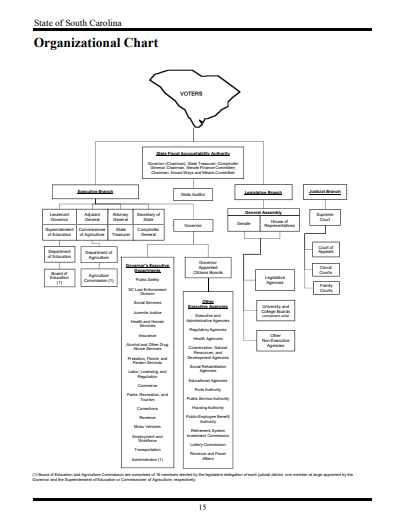
By ASHLEY LANDESS
Most Nerve readers know that South Carolina’s governor doesn’t control transportation, education, the pension system or every regulatory entity. But an important state financial document says otherwise, and that is cause for concern.
As The Nerve reported last week, a chart depicting the chain of accountability in state government misrepresents who is really in control.
The “Organizational Chart” (Chart) contained in the Comprehensive Annual Financial Report (CAFR) adds to the larger picture emerging of disingenuous borrowing practices in South Carolina.
That should matter very much to South Carolinians.
Taxpayers owe billions with interest, borrowed for projects and programs that rarely benefit most citizens. Even worse than the cost of state debt is how it’s guaranteed – South Carolinians’ property is the ultimate collateral.
That’s why South Carolinians should care about a one-page chart in an accounting document whose primary audiences are credit raters and bondholders.
The CAFR is produced by states in part to provide lenders with consistent criteria to determine credit risk. The reports are done in compliance with governmental accounting standards.
That’s why the Chart, which is included in the CAFR, raises red flags. Its purpose is to represent accountability in state government, presumably to inform lenders as to who has ultimate authority to manage state agencies.
But the recent version of the Chart doesn’t accurately reflect who runs state government. Anyone viewing it would conclude that government branches are properly separated and the governor has ultimate authority over agencies.
That isn’t the case. Most of state government is actually controlled by a handful of state legislators, resulting in dangerously flawed system that is largely unaccountable to the people.

While South Carolinians are learning that our government is largely beyond our control, the rest of the country doesn’t know that – and they won’t learn the truth looking at the Chart.
For example, the Chart presents the broad category of “Transportation” as a cabinet agency directly under the governor’s control. That is just not true and never has been. The Department of Transportation is controlled by a commission to which legislative delegations ultimately decide the majority of appointments.
Furthermore, the State Transportation Infrastructure Bank (STIB) is nowhere on the Chart despite carrying the second-highest debt of any state entity. The STIB is certainly not a cabinet agency; the majority of the board is appointed by legislative leaders.
According to the Chart, the governor also controls “educational agencies,” as well as the pension system, when, in reality, the most powerful of those agencies have a majority of legislatively controlled appointments.
What’s missing from the Chart? The entire regulatory system governing utilities, excluding state-owned Santee Cooper. Those entities are entirely controlled by lawmakers, some of whom sit on one of the boards.
With ratepayers on the hook for billions in V.C. Summer debt, the heavily regulated, government-dependent utility system should matter in the overall financial picture of the state. But the Chart depicts none of that.
And what of the state’s judicial system? With a few exceptions such as probate and municipal judges, legislators fully control the appointments to the courts, including the Supreme Court, Court of Appeals and Circuit Courts.
But according to the Chart, no one appoints the judges. There is no line connecting the judicial branch to an appointing authority at all.
It seems state officials would rather omit the judicial accountability chain altogether than admit the Legislature largely controls judicial appointments.
One dishonest chart may not seem like much on its own, and it would be fair to ask why we’re focused on it. But in the context of the larger debt practices there is more reason to be concerned.
Credit agencies evaluate state government when determining credit-worthiness. In fact, Moody’s – among the most influential credit raters – considers governance as 20 percent of a state’s score.
Disingenuous representation of state government might seem trivial, but together with unlawful funneling of gas tax dollars to the STIB – prohibited by the state constitution – and the hundreds of millions of dollars borrowed to benefit specific companies (also prohibited by the constitution), there is a larger problem.
And there’s more. Don’t forget about legislators sneaking in an automatic, limitless property tax into the S.C. Constitution in the ‘70s that guaranteed state debt. That language was conveniently left off of the ballot – South Carolinians had no idea they put their homes up for collateral when they voted.
Ultimately it’s unlikely that the inaccurate portrayal of state government will worry the debt community. Bondholders they know they’ll get their money, even if it means a new tax on South Carolinians’ homes.
To be clear, no one is challenging data or other information in the CAFR. The Comptroller General’s Office stands by the Chart, saying it’s a matter of interpretation; and the CAFR was certified by the Government Finance Officers Association.
But the fact remains that the Chart depicting the governance of our state is inaccurate. It would seem our government is so flawed that state officials want to hide it – and that’s problematic on multiple levels.
Public trust has already been violated by legislators’ unconstitutional borrowing and the hidden threat of a new property tax. That won’t change until separation of powers is implemented and citizens ultimately do control government. In the meantime, citizens should monitor state borrowing practices and demand answers from those who really call the shots.
Ashley Landess is president of the South Carolina Policy Council, The Nerve‘s parent organization.
